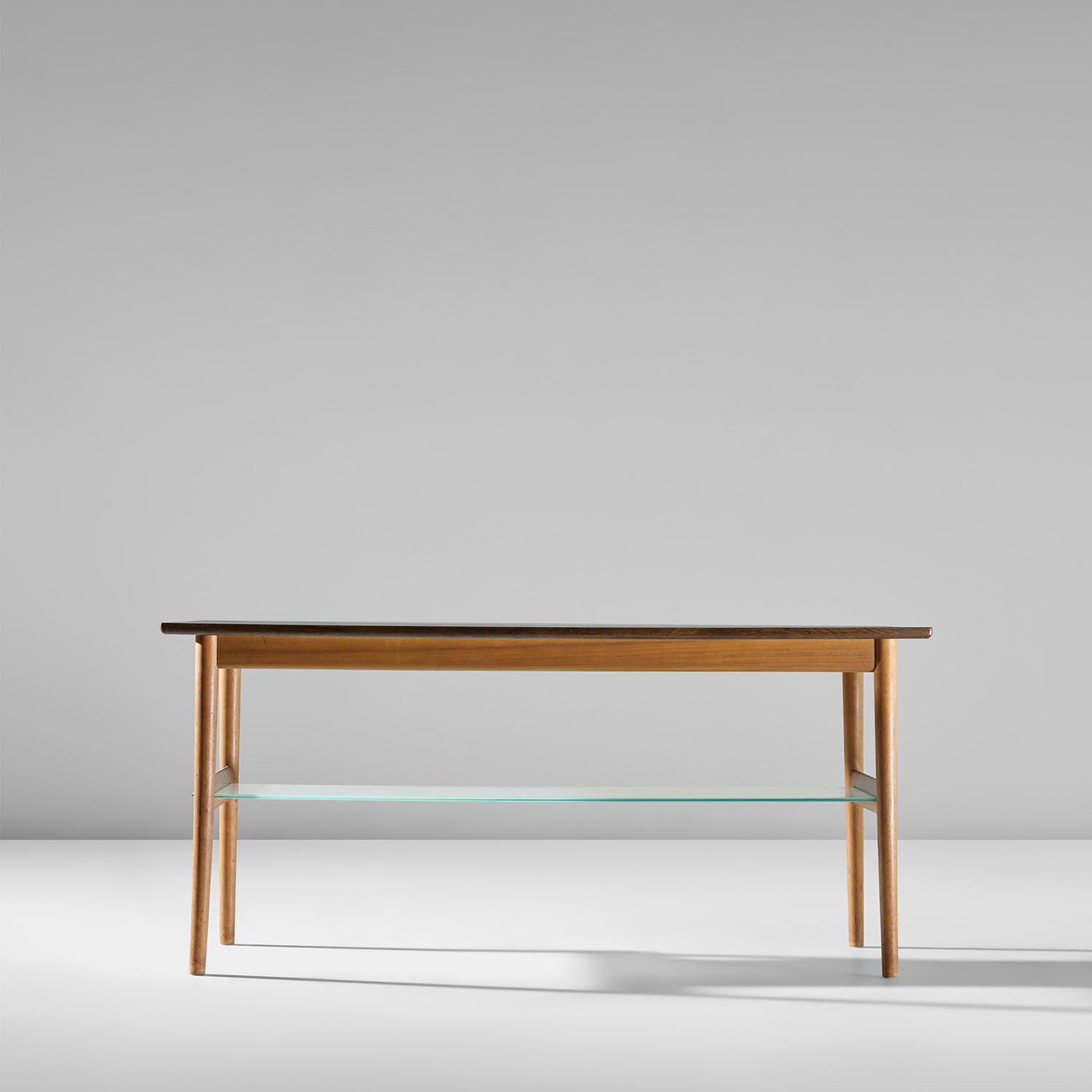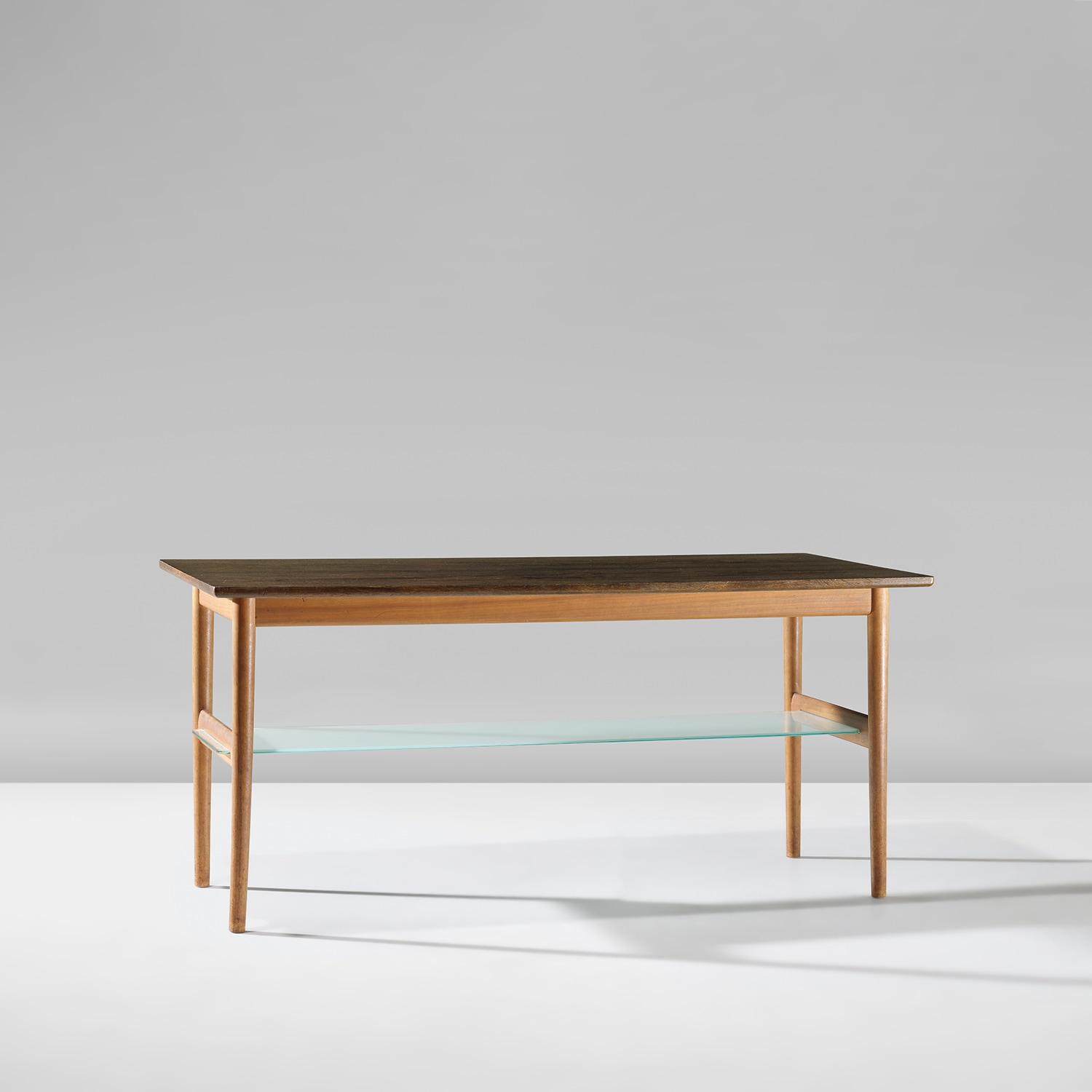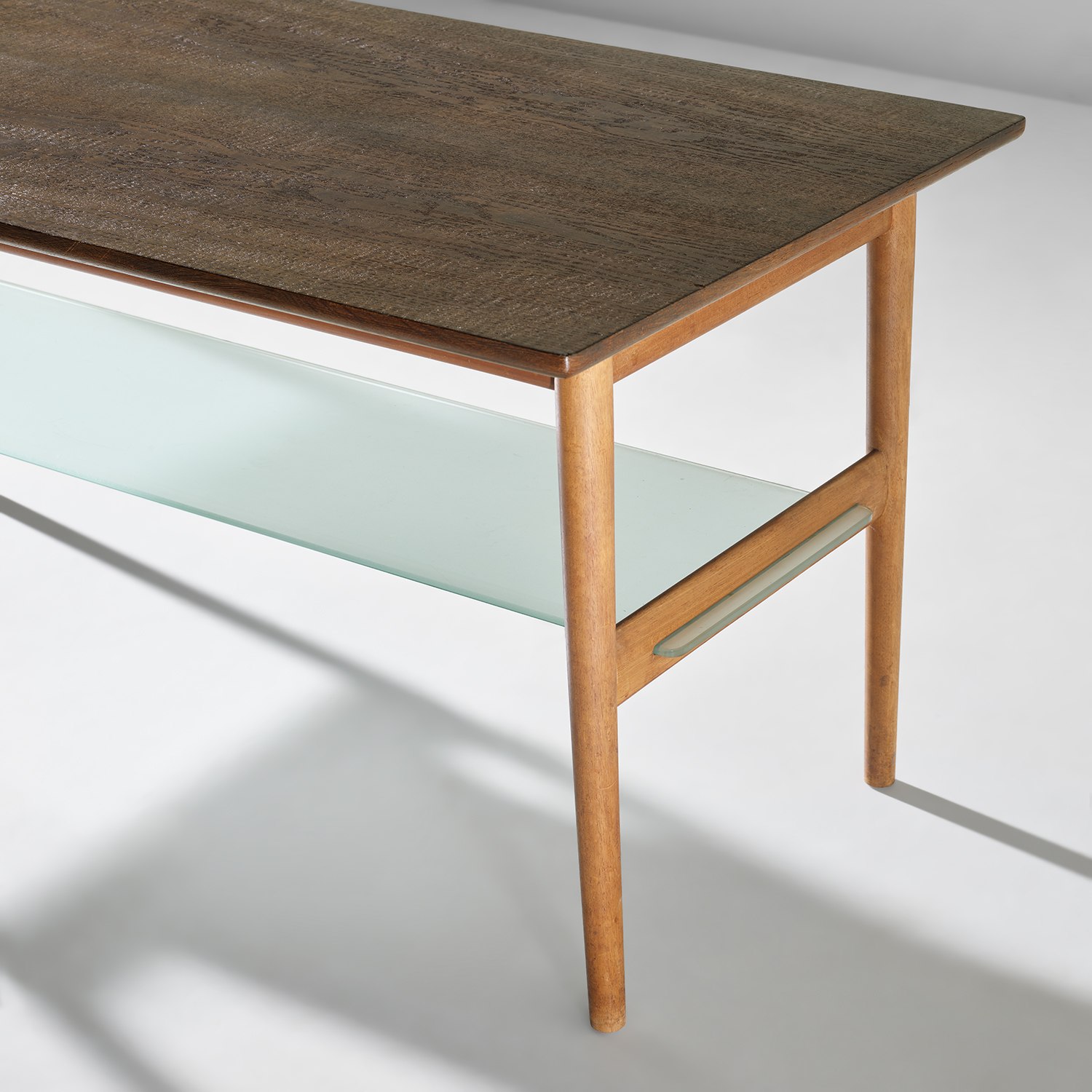









70
Finn Juhl
Rare coffee table
circa 1953
Walnut, oak, oak veneered-wood, acid-etched coloured glass.
60 x 129.5 x 64.5 cm (23 5/8 x 50 7/8 x 25 3/8 in.)
Executed by master cabinetmaker Niels Vodder, Denmark. Underside impressed MAKER NIELS VODDER/DENMARK/DESIGN FINN JUHL.
Full-Cataloguing
Finn Juhl reached a pinnacle in his career in the late 1940s, delivering now-iconic works such as the 'Chieftain' chair which demonstrated his innovative and unprecedented imbuement of global design influences from the Bauhaus, International Style and exoticism into the deeply traditional and relatively insular Danish furniture industry. Because of these radical stylistic propensities, along with a comfortability to veer away from rigid adherence to traditional fabrication techniques as favoured by his contemporaries, Juhl garnered a reputation for being especially individualistic with his designs, which were constructed by cabinetmaker Niels Vodder through a successful creative partnership over many years. Unlike other Scandinavian architects who also came to design furniture, Juhl did not have formal training in cabinetmaking, a factor which contributed to his amiability to new and different approaches in his designs due to not having developed a committed practice utilising long-established, conventional production methods. Vodder's executions of Juhl’s revolutionary designs, presented at the annual cabinetmakers’ guild exhibitions in Copenhagen, commanded attention (not always positive – critical responses to his work were quite polarised due to their departure from more conventional standards), and the designer soon attained a reputation for his willingness to be daring that earned him international acclaim and commissions abroad.
The present coffee table, believed to be unique, represents a period in the designer’s career following those breakthrough years, when he had reached a point of stylistic maturation while demonstrating skilled restraint articulated by nuanced elegance only achievable after many years of thoughtful experimentation. The sculptural wooden form of the frame and stretchers exhibit Juhl's affinity for the artworks of Henry Moore, Jean Arp and Barbara Hepworth, but also echo organic shapes of the Scandinavian landscape and suggest a deep connection with the natural beauty of his homeland. Water was an integral part of Juhl's professional life, and his appreciation for the element is present throughout his career in the watercolour details added to imbue a relaxed, lifelike quality to the technical drawings of his designs, which could otherwise be quite cold and austere. The delicate medium brings a gentleness to his concepts which better conveys their stylish comfort, achieved through a carefully honed talent to masterfully blend sculptural expression with intentional, structural clarity. These sentiments are celebrated here through the subtle sea-glass tint of the glass panel, which proposes aquatic notions through both its colour and as it echoes the functional, wooden surface above.
The gentle thematic suggestion of marine elements is again implied through the use of wood finished to specifically highlight, not hide, its natural texture. In the present lot, Juhl has poetically positioned the panels with the grain mirrored along the coffee table’s surface, imparting an ephemeral quality of fluidity by mimicking the movement of tidal waves. The selected soft lime finish imparts a weathered effect, enabling the work to fit seamlessly into its environment by bringing a sense of warm familiarity. The culmination of these individual qualities results in a harmonious composition of light, form, space and colour, showcasing the designer's evolved talent through the table's quiet, disciplined balance.
The present coffee table, believed to be unique, represents a period in the designer’s career following those breakthrough years, when he had reached a point of stylistic maturation while demonstrating skilled restraint articulated by nuanced elegance only achievable after many years of thoughtful experimentation. The sculptural wooden form of the frame and stretchers exhibit Juhl's affinity for the artworks of Henry Moore, Jean Arp and Barbara Hepworth, but also echo organic shapes of the Scandinavian landscape and suggest a deep connection with the natural beauty of his homeland. Water was an integral part of Juhl's professional life, and his appreciation for the element is present throughout his career in the watercolour details added to imbue a relaxed, lifelike quality to the technical drawings of his designs, which could otherwise be quite cold and austere. The delicate medium brings a gentleness to his concepts which better conveys their stylish comfort, achieved through a carefully honed talent to masterfully blend sculptural expression with intentional, structural clarity. These sentiments are celebrated here through the subtle sea-glass tint of the glass panel, which proposes aquatic notions through both its colour and as it echoes the functional, wooden surface above.
The gentle thematic suggestion of marine elements is again implied through the use of wood finished to specifically highlight, not hide, its natural texture. In the present lot, Juhl has poetically positioned the panels with the grain mirrored along the coffee table’s surface, imparting an ephemeral quality of fluidity by mimicking the movement of tidal waves. The selected soft lime finish imparts a weathered effect, enabling the work to fit seamlessly into its environment by bringing a sense of warm familiarity. The culmination of these individual qualities results in a harmonious composition of light, form, space and colour, showcasing the designer's evolved talent through the table's quiet, disciplined balance.